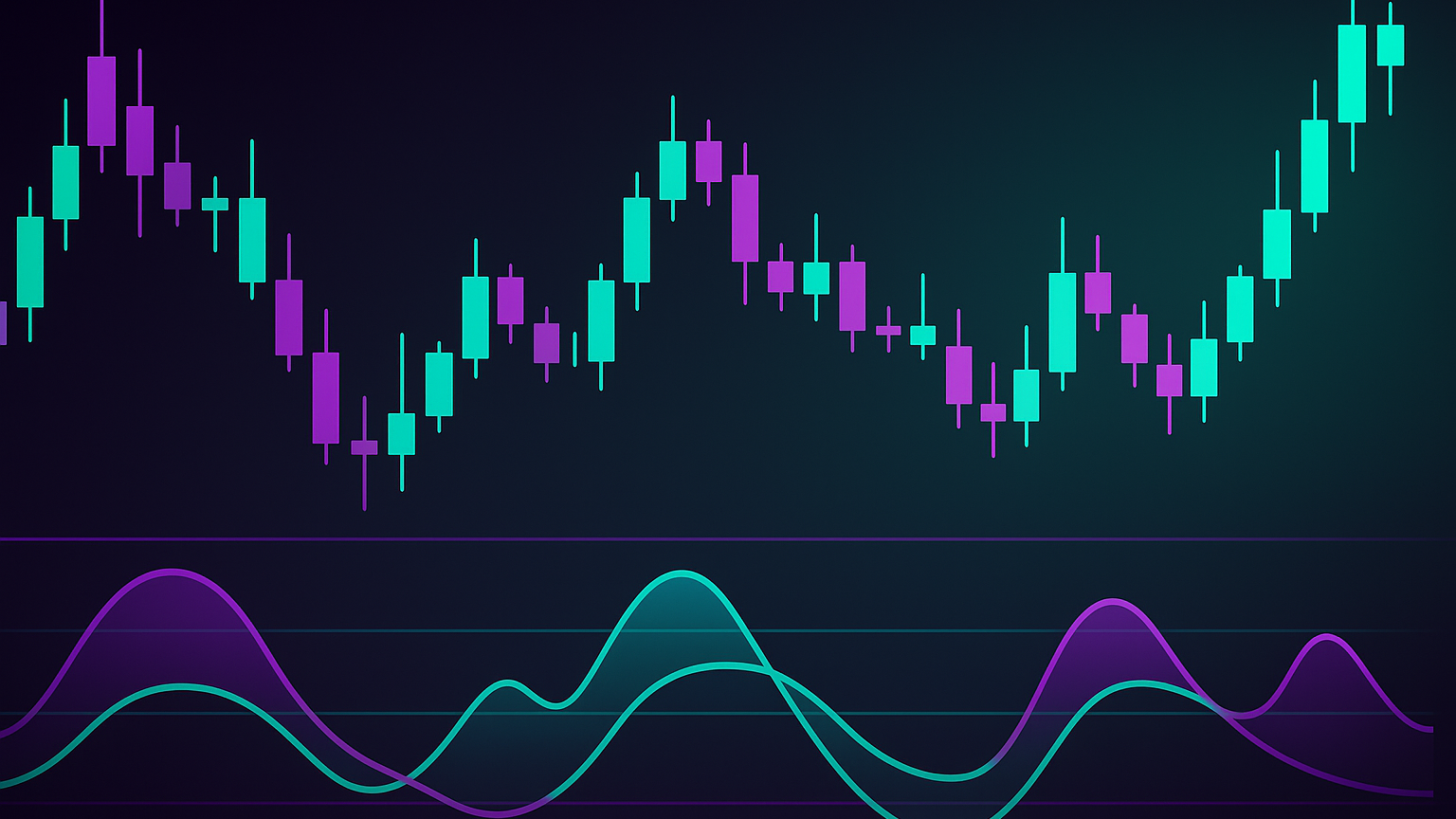Explore the Percentage Price Oscillator (PPO) and MACD indicators, their calculations, and how to leverage them for effective trading strategies.
The Percentage Price Oscillator (PPO) is a momentum tool that compares two moving averages as a percentage. Unlike the MACD, which shows absolute differences, the PPO expresses these differences in percentages, making it easier to evaluate momentum across securities with varying price levels. For context on MACD specifically, see this primer from Investopedia.
Key Takeaways:
- PPO Formula:
PPO = \[\frac{(12\text{-period EMA} - 26\text{-period EMA})}{26\text{-period EMA}}\] \times 100 — if you need a refresher on EMAs, here’s a quick guide to the Exponential Moving Average (EMA). - PPO Benefits: Ideal for comparing momentum across multiple securities, regardless of price. Great for portfolio management and sector analysis (see sector rotation basics).
- MACD Focus: Tracks momentum in absolute price terms, better suited for analyzing individual securities.
Quick Comparison:
| Feature | PPO | MACD |
|---|---|---|
| Calculation | Percentage-based difference | Absolute dollar difference |
| Best For | Comparing multiple assets | Single-asset analysis |
| Signals | Zero-line crossovers, divergences | Same, with histogram for depth |
| Sensitivity | Scaled to volatility | Direct price sensitivity |
Both indicators confirm trends rather than predict them and are best paired with other tools for a clearer market view. Consider exploring LuxAlgo’s Signals & Overlays or the Oscillator Matrix for complementary analysis.
1. Percentage Price Oscillator (PPO)
Calculation Method
The Percentage Price Oscillator (PPO) is calculated in three straightforward steps. First, determine two exponential moving averages (EMAs) using different time periods—commonly a 12-period EMA for the fast line and a 26-period EMA for the slow line. Then, subtract the slow EMA from the fast EMA to find the difference. Finally, divide this difference by the slow EMA and multiply by 100 to convert it into a percentage. If you want additional EMA context, see Fidelity’s EMA explainer.
The formula for PPO is:
PPO = [(12-period EMA - 26-period EMA) / 26-period EMA] × 100
Typical ranges depend on the asset and timeframe—values between roughly −10% and +10% are common for many liquid equities, but highly volatile assets can exceed these bounds. For example, a PPO reading of +5% indicates that the short-term EMA is 5% higher than the long-term EMA, signaling upward momentum.
This percentage-based approach not only simplifies interpretation but also makes it easier to compare momentum across different securities. For a practical momentum companion on TradingView, you can also review LuxAlgo’s Moving Averages Proximity Oscillator.
Applicability Across Securities

One of the key advantages of the PPO is its percentage-based format, which makes it highly versatile for comparing momentum across various securities, regardless of their price levels. Unlike absolute price differences, percentage changes provide a more meaningful and consistent basis for analysis.
Take, for example, a portfolio containing Apple (AAPL) at around $180 per share and Berkshire Hathaway Class A (BRK.A) priced over $500,000 per share. A $5 price move means very different things for these stocks in absolute terms. However, the PPO normalizes these differences by expressing momentum as percentages, allowing for direct comparisons. This makes it easier to identify which security has stronger relative momentum.
This feature is especially useful for sector rotation strategies and portfolio management. By scanning PPO readings across various asset types—stocks, bonds, commodities, or currencies—you can quickly pinpoint where momentum is accelerating or fading. This insight helps guide decisions on capital allocation, directing investments toward opportunities with the most potential. For a multi-indicator approach, consider LuxAlgo’s Market Sentiment Technicals.
Trend and Momentum Analysis
Once you understand how the PPO is calculated and applied, the next step is interpreting its signals. The PPO generates trading signals through zero-line crossovers and signal line interactions. When the PPO crosses above zero, it indicates upward momentum, while a drop below zero suggests bearish momentum.
Zero-line crossovers highlight basic momentum shifts, but adding a 9-period EMA as a signal line refines these signals. A bullish crossover occurs when the PPO line moves above the signal line, while a bearish crossover happens when the PPO line falls below it.
Another valuable use of the PPO is divergence analysis. Bearish divergence occurs when prices hit new highs but the PPO fails to do the same, often signaling a potential reversal. Conversely, bullish divergence happens when prices make new lows, but the PPO shows higher lows, hinting at a possible upward reversal. Learn more about the concept of divergence in technical analysis.
Additionally, the PPO can help identify overbought and oversold conditions in trending markets. Readings above +8% or +10% may indicate short-term overbought conditions, while readings below −8% or −10% could suggest oversold conditions. However, these thresholds can vary depending on the typical volatility of the security being analyzed. For more momentum tools, explore RSI Candlestick Oscillator or LuxAlgo’s Market Structure Oscillator.
2. Moving Average Convergence Divergence (MACD)
Calculation Method
The Moving Average Convergence Divergence (MACD) indicator uses the same exponential moving averages (EMAs) as the Percentage Price Oscillator (PPO), but it measures the difference in price units rather than percentages.
Here’s how MACD is calculated:
MACD Line = 12-period EMA - 26-period EMA
Signal Line = 9-period EMA of the MACD Line
Histogram = MACD Line - Signal Line
For example, if a stock is trading at $100 and the MACD shows a reading of +2.5, it means the short-term EMA is $2.50 higher than the long-term EMA. This measurement in dollar terms provides a straightforward way to gauge price momentum, helping traders assess the size of price movements directly. For additional hands-on tools, see LuxAlgo’s Targets For Many Indicators.
Applicability Across Securities
One limitation of MACD is that its absolute values make it challenging to compare momentum across different securities. A single MACD reading can represent vastly different levels of momentum depending on the stock’s price.
For instance, take Ford Motor Company (F) trading at around $12 per share and Amazon (AMZN) trading near $140 per share. A MACD reading of +1.0 translates to roughly 8.3% momentum for Ford but only 0.7% for Amazon. Without additional calculations, it’s hard to determine which stock has stronger relative momentum.
That said, MACD shines when analyzing a single security. Its focus on absolute price changes makes it ideal for traders who prioritize dollar-based movements. Day traders and swing traders, in particular, find MACD valuable for setting stop-loss levels or determining position sizes, as it directly reflects potential gains or losses in dollar terms. For a quick primer on order types used in risk controls, see the SEC’s overview of stop, stop-limit, and trailing stop orders.
Trend and Momentum Analysis
MACD builds on its momentum-tracking capabilities with features that enhance trend analysis. Like the PPO, a zero-line crossover indicates a shift in momentum. However, MACD adds depth through its signal line and histogram, which provide clearer entry and exit points. A bullish signal occurs when the MACD line crosses above the signal line, often marking a good point to enter a trade.
The MACD histogram is particularly useful for spotting changes in momentum. A growing histogram suggests momentum is accelerating, while a shrinking one points to slowing momentum and potential reversals.
Divergence analysis is another strength of MACD. Because it uses absolute values, shifts in momentum can be more pronounced compared to percentage-based indicators. For example, if a stock hits a new high but the MACD doesn’t, the divergence becomes more noticeable, offering traders an early warning of a potential reversal.
MACD also excels at identifying trend strength during sustained moves. In strong uptrends, the MACD line typically remains above the signal line with a widening histogram. If the histogram starts to shrink while prices continue climbing, it’s a sign that the trend might be losing momentum, even if the price hasn’t reversed yet. This makes MACD a valuable tool for traders looking to gauge the strength of a trend and anticipate potential turning points, complementing the percentage-based focus of PPO in unique ways. For broader technical context, CME Group has a concise technical analysis course overview.
Technical Indicators: The MACD vs The PPO | David Keller, CMT
Advantages and Disadvantages
PPO and MACD are both built on historical data, which means they naturally function as lagging indicators. Instead of predicting trends, they confirm them only after the trends have already begun. In fast-moving or volatile markets, this delay can lead to late trade signals. To address this, traders might consider combining these tools with leading indicators or other strategies to enhance timing and make more informed decisions. On TradingView, LuxAlgo provides a broad set of resources—see the Library, Backtesters, and the AI Backtesting Assistant to experiment and compare logic consistently.
Conclusion
The PPO and MACD are both useful tools for analyzing market momentum, but their unique calculation methods make them better suited for different trading situations. The PPO's percentage-based approach makes it ideal for comparing momentum across assets with varying price levels, while the MACD's focus on absolute dollar differences is more effective for analyzing individual securities.
For traders managing multiple assets—such as in portfolio management or sector rotation—the PPO's percentage normalization allows for easier comparison of momentum strength between assets. On the other hand, the MACD shines in single-asset analysis, where tracking absolute price movements is more relevant.
In trending markets, the PPO can help identify momentum shifts effectively. For instance, readings above +10 or below −10 often signal overbought or oversold conditions, potentially pointing to reversal opportunities. For an alternative reference, see StockCharts’ PPO guide. While the standard EMA settings (12-period and 26-period) work well for most scenarios, tweaking these parameters to align with your trading timeframe and an asset's volatility can improve accuracy.
To strengthen your analysis, consider combining PPO signals with other technical indicators. For example, bullish divergences—when prices hit lower lows but the PPO forms higher lows—or bearish divergences—when prices reach higher highs but the PPO shows lower highs—can signal upcoming trend changes. Keep in mind that both the PPO and MACD are based on moving averages, meaning they lag behind price action. In sideways or choppy markets, where false signals are more likely, use additional tools and analysis to confirm trends and manage risk effectively. You can also study pattern- and structure-based signals using Price Action Concepts or the Market Flow Trend Lines & Liquidity toolkit.
FAQs
How does the Percentage Price Oscillator (PPO) compare momentum between securities with different price levels?
The Percentage Price Oscillator (PPO) helps traders analyze momentum across securities with different price levels by showing the difference between two moving averages as a percentage of the larger moving average. This approach ensures results stay consistent, no matter the security's actual price. If you’d like a multi-signal view on TradingView, LuxAlgo’s Signals & Overlays and Oscillator Matrix offer complementary perspectives.
By using this percentage-based method, the PPO simplifies the comparison of momentum strength and direction. It gives traders a better view of relative performance, allowing them to spot trends and make smarter decisions across various assets.
How does the PPO indicator differ from the MACD when analyzing trends and momentum?
The PPO (Percentage Price Oscillator) and MACD (Moving Average Convergence Divergence) are both popular tools for analyzing trends and momentum, but they approach this task differently. The PPO calculates the difference between two EMAs (Exponential Moving Averages) as a percentage of the longer EMA. This percentage-based method makes it easier to compare assets with varying price levels or across different timeframes. On the other hand, the MACD shows the absolute difference between the EMAs, offering a simpler view but making it less effective for comparing assets with large price disparities.
The PPO shines when analyzing stocks with wide price ranges, as its normalized approach provides a clearer picture of momentum. The MACD, however, is more suitable for evaluating absolute price changes. While both indicators are excellent for identifying trend reversals and momentum shifts, the PPO's percentage-based design offers greater flexibility for analyzing multiple assets or timeframes.
How can traders use the PPO alongside other indicators to improve their trading strategies?
Traders can refine their approach by pairing the Percentage Price Oscillator (PPO) with other technical tools like the Relative Strength Index (RSI), volume analysis, and support and resistance levels. These combinations can help validate PPO signals and minimize the chances of acting on false trends.
For instance, the PPO can highlight momentum shifts, while the RSI can indicate if the market is overbought or oversold, offering a more complete view of price behavior. Adding volume analysis or observing key price levels further enhances trend confirmation, providing stronger insights for decision-making. If you want to test configurations across assets and timeframes, try LuxAlgo’s Backtesters or AI Backtesting Assistant to iterate faster.
References
- LuxAlgo Library
- Signals & Overlays
- Oscillator Matrix
- Trending Market Toolkit
- Battle Signals
- Market Structure Oscillator
- RSI Candlestick Oscillator
- Moving Averages Proximity Oscillator
- Targets For Many Indicators
- Market Flow Trend Lines & Liquidity
- Price Action Concepts
- LuxAlgo Backtesters
- AI Backtesting Assistant
- Moving Averages: Essential Trend Analysis Tool (Blog)
- Reversal Spotting Made Easy (Blog)
External Resources
- Investopedia — Percentage Price Oscillator (PPO)
- Investopedia — MACD
- Investopedia — Exponential Moving Average (EMA)
- Investopedia — Sector Rotation
- Investopedia — Divergence (Technical Analysis)
- SEC — Investor Bulletin on Stop Orders
- StockCharts — PPO Guide
- CME Group — Technical Analysis Course Overview
- Fidelity — EMA Indicator Guide








